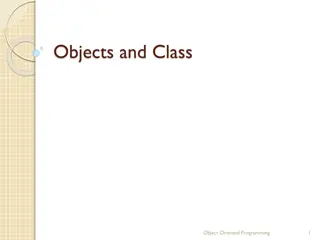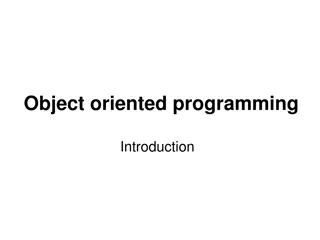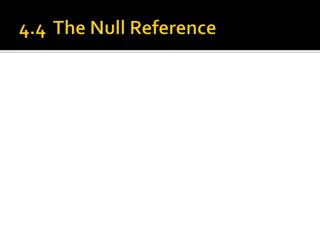
Understanding Object-Based Programming in Python
Learn about object-based programming in Python, including creating classes, objects, and constructors. Explore how to define attributes and behaviors within objects to build more structured and versatile programs.
Download Presentation

Please find below an Image/Link to download the presentation.
The content on the website is provided AS IS for your information and personal use only. It may not be sold, licensed, or shared on other websites without obtaining consent from the author. If you encounter any issues during the download, it is possible that the publisher has removed the file from their server.
You are allowed to download the files provided on this website for personal or commercial use, subject to the condition that they are used lawfully. All files are the property of their respective owners.
The content on the website is provided AS IS for your information and personal use only. It may not be sold, licensed, or shared on other websites without obtaining consent from the author.
E N D
Presentation Transcript
15-110: Principles of Computing Object-Based Programming: Part I Lecture 19, November 13, 2018 Mohammad Hammoud Carnegie Mellon University in Qatar
Today Last Session: Problem Solving and Discussion on HA05's Problems Today s Session: Objects and Object-Based Programming Announcements: HA05 is due on November 17 by midnight Quiz II is on November 20 during the class time
Objects Python is an object-oriented programming language An object is a combination of variables (also called attributes or instance variables or object variables) and behaviors (i.e., functions, which are referred to as methods in the object context) To create an object, you need to create a class using the keyword class as follows: class Student: sname = "Mohammad" An attribute; you can have as many attributes as you want
Creating Objects Out of Classes After defining a class, you can create any number of objects out of it s1 = Student() print(s1.sname) s2 = Student () print(s2.sname) s3 = Student () print(s3.sname) But, all of the above students have the same name! How can we have student objects with different names?
Class Constructor All classes in Python have a function called __init__(), which is always executed when the class is being initiated (i.e., an object out of it is created) You can use the __init__() function to assign values to object attribute(s) as a matter of fact, you can add any code in the __init__() function that you may find necessary for creating objects out of your class class Student: def __init__(self, sn): self.sname = sn The __init__() function is called the constructor or the initializer
Class Constructor All classes in Python have a function called __init__(), which is always executed when the class is being initiated (i.e., an object out of it is created) You can use the __init__() function to assign values to object attribute(s) as a matter of fact, you can add any code in the __init__() function that you may find necessary for creating objects out of your class class Student: def __init__(self, sn): self.sname = sn The constuctor should always have the keyword self as its first parameter
Creating Objects Out of Classes You can now create as many students as you like with different names s1 = Student12("Khaled") print(s1.sname) s2 = Student12("Eman") print(s2.sname) s3 = Student12("Omar") print(s3.sname) Is there any other way for assigning different names to different students?
Methods You can assign different values to attributes through functions/methods, which you can define in your classes class Student: sname = "" def setSName(self, sn): self.sname = sn Every method in a Python class should have self as its first parameter s1 = Student12() s1.setSName("Omar") print(s1.sname)
Methods You can assign different values to attributes through functions/methods, which you can define in your classes class Student: sname = "" def setSName(self, sn): self.sname = sn Every attribute in a Python class should be always prefaced with self. upon accessing it s1 = Student12() s1.setSName("Omar") print(s1.sname)
Constructor and Methods You can also define __init__() alongside any other function/method class Student12: def __init__(self, sn): self.sname = sn def setSName(self, sn): self.sname = sn def getSName(self): return self.sname s1 = Student12("Eman") print(s1.getSName()) s1.setSName("Eman2") print(s1.getSName())
Example: Students and Courses Let us write an object-based program for the following two classes Class: Student Class: Course Attributes (or Instance Variables) Attributes (or Instance Variables) sname cname Many students can register for one course sid cid syear slist (a list which holds student objects) Behaviors (or Methods) Behaviors (or Methods) getSName() getCName() getSid() getCid() getSYear() printAllStudents() setSYear(year) addStudent(Student)
Example: Students and Courses class Student: def __init__(self, sn, sid, sy): self.sname = sn self.sid = sid self.syear = sy def getSName(self): return self.sname def getSid(self): return self.sid
Example: Students and Courses def getSYear(self): return self.syear def setSYear(self, sy): if type(sy) is str and (sy.lower() == "freshman" or sy.lower() == "sophomore" or sy.lower() == "junior" or sy.lower() == "senior"): self.syear = sy else: print("You have input an invalid value! The only allowable input are freshman, sophomore, junior, and senior")
Example: Students and Courses class Course: def __init__(self, cn, cid, sl): self.cname = cn self.cid = cid self.slist = sl def getCName(self): return self.cname def getCid(self): return self.cid
Example: Students and Courses def printAllStudents(self): for i in self.slist: print(i.getSName(), i.getSid(), i.getSYear()) def addStudent(self, st): if type(st) is Student: for i in self.slist: if i is st: print("This student is already added to the course!") return self.slist.append(st) else: print("Sorry, this is not a student!")
Example: Students and Courses c1 = Course("Prinicples of Computing", 15110, []) s1 = Student("Eman", 100, "Freshman") s2 = Student("Omar", 101, "Freshman") s3 = Student("Khaled", 102, "Junior") c1.addStudent(s1) c1.addStudent(s2) c1.addStudent(s3) c1.printAllStudents()
Next Class More examples on object-based programming





















